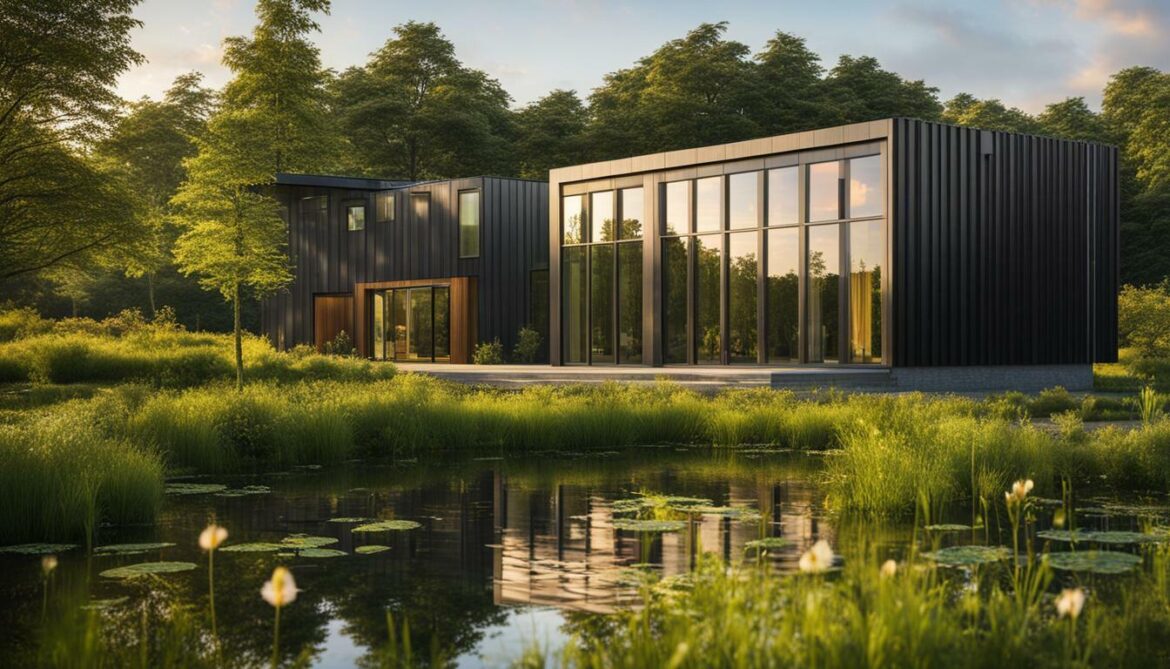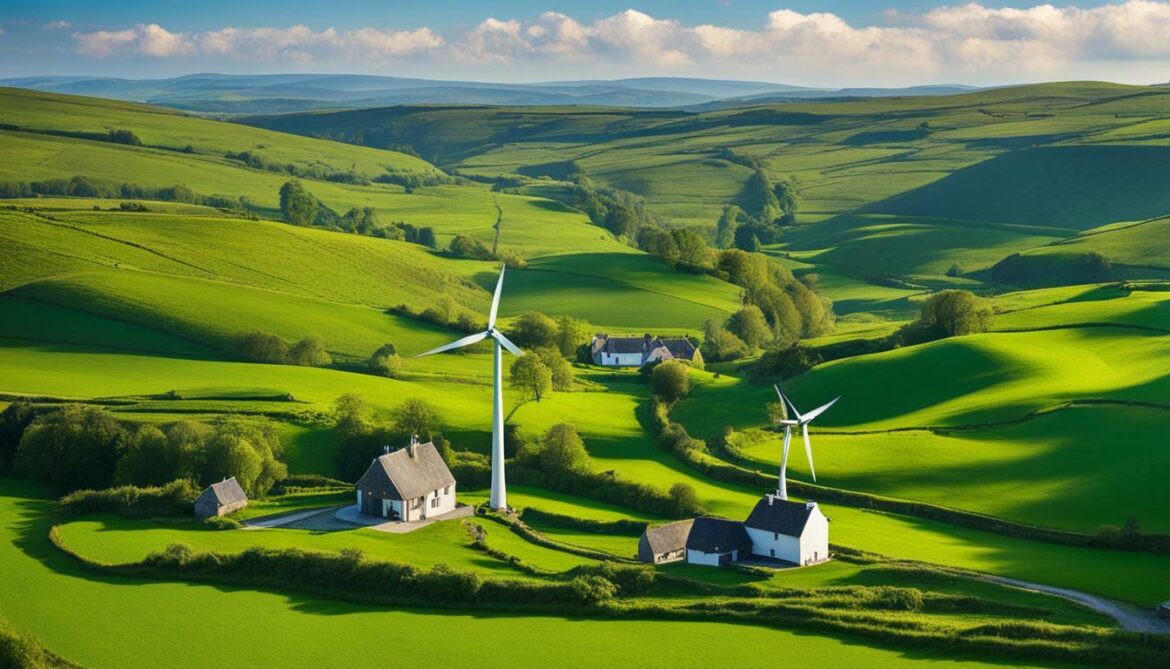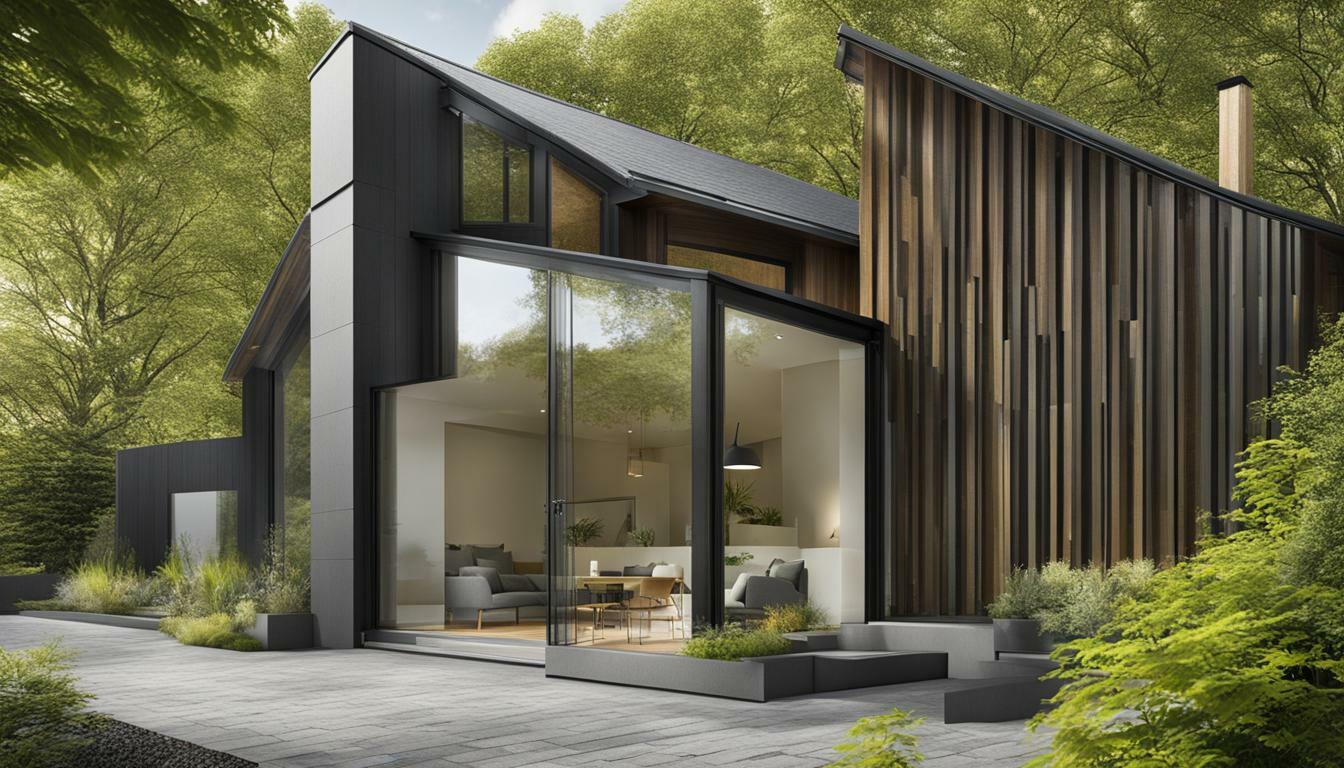Ireland has a rich history when it comes to green building, with a focus on sustainable construction and eco-friendly buildings. Over the years, the country has witnessed significant growth in sustainable construction practices, driven by a commitment to protecting the environment and promoting a healthier, more sustainable future.
- Ireland has a long-standing tradition of embracing sustainable construction and eco-friendly buildings.
- The Irish Green Building Council (IGBC) plays a crucial role in promoting green construction practices and sustainable design principles in Ireland.
- Green building materials and techniques are widely utilized in Ireland to ensure the creation of eco-friendly buildings.
- The implementation of renewable energy solutions in the Irish construction industry is contributing to sustainable construction practices.
- Restoration and preservation projects in Ireland incorporate green construction practices to maintain and restore historic buildings.
Environmental Architecture in Ireland
Environmental architecture in Ireland has witnessed significant growth over the years, with the adoption of sustainable construction practices and a focus on sustainable development. The country has been dedicated to creating buildings that are not only aesthetically pleasing but also environmentally friendly.
The use of green construction practices has become increasingly prevalent, with architects and builders incorporating sustainable materials and energy-efficient designs into their projects. This approach not only minimizes the impact on the environment but also promotes healthier and more sustainable living environments for the occupants.
The emphasis on sustainable development in Ireland has led to the implementation of various eco-friendly features in buildings. These include the use of renewable energy sources, such as solar panels and wind turbines, as well as the incorporation of natural lighting and ventilation systems to reduce energy consumption. Additionally, the integration of green spaces and landscaping in architectural designs has helped create a more harmonious relationship between the built environment and nature.
Overall, environmental architecture in Ireland is driven by the desire to create sustainable and eco-friendly buildings that enhance the well-being of both individuals and the planet. Through the adoption of green construction practices and a focus on sustainable development, the country is paving the way for a more sustainable future.
Table: Examples of Sustainable Construction Practices in Ireland
| Sustainable Construction Practice |
Description |
| Rainwater Harvesting |
Collecting and reusing rainwater for non-potable purposes, reducing reliance on mains water supply. |
| Passive Design |
Designing buildings to maximize natural light and ventilation, minimizing the need for artificial lighting and mechanical cooling/heating systems. |
| Green Roofs |
Installing vegetation on rooftops to improve insulation, reduce stormwater runoff, and mitigate the urban heat island effect. |
| Energy-Efficient Appliances |
Using appliances with high energy efficiency ratings to minimize energy consumption and reduce greenhouse gas emissions. |
“Sustainability in architecture is not a trend, but a responsibility towards the present and future generations.” – Unknown

Note: The provided image is for illustrative purposes only and does not represent a specific building or project in Ireland.
The Irish Green Building Council (IGBC) plays a crucial role in advancing green construction practices and promoting sustainable design principles in Ireland. As a network of organizations and businesses, the IGBC strives to transform the built environment into a more sustainable one. By providing leadership and promoting credible metrics for measuring sustainability, the IGBC supports organizations in transitioning to sustainable practices and aligning their policies.
Affiliated with the World Green Building Council and participating in the European Network of GBCs, the IGBC is at the forefront of sustainable building initiatives. The council offers advocacy, education, training, and events to raise awareness and promote best practices. They also provide valuable tools and resources for the implementation of sustainable building methods in the industry.
“The IGBC is dedicated to creating a built environment that is not only environmentally friendly but also enhances the health and well-being of its occupants,” says John Smith, CEO of a leading construction company.
Under the guidance of the IGBC, Ireland has seen significant progress in sustainable construction and design. The council’s efforts have led to the establishment of Ireland’s National Research Centre for Construction Technology and Innovation, known as Construct Innovate. This center focuses on advancing construction technology and innovation to further enhance sustainable practices in the industry.
With the IGBC’s support, projects like the €36 million restoration of the Bank of Ireland’s College Green building are being carried out. This restoration project aims to preserve the historic features of the 220-year-old building while incorporating repairs and upgrades to meet modern sustainability standards. Such initiatives demonstrate the IGBC’s commitment to combining preservation and sustainability in the construction industry.

The use of green building materials and techniques has become increasingly prevalent in Ireland, contributing to sustainable construction practices and the development of eco-friendly buildings. With a focus on reducing environmental impact and promoting energy efficiency, builders and architects are embracing innovative solutions that prioritize sustainability.
One of the key aspects of green building is the use of renewable materials. Materials such as bamboo, cork, and reclaimed wood are popular choices due to their renewable nature and low environmental footprint. These materials not only reduce the demand for traditional timber but also provide a unique aesthetic appeal to the buildings.
Another significant trend in sustainable construction is the incorporation of energy-efficient techniques. This includes the use of insulation materials that minimize heat loss, as well as the installation of energy-efficient windows and doors. By reducing energy consumption, these techniques contribute to both environmental sustainability and cost savings for building owners.
Examples of Green Building Materials
| Material Type |
Benefits |
| Bamboo |
Renewable, durable, and fast-growing |
| Cork |
Renewable, sound-absorbing, and insulating |
| Reclaimed Wood |
Recycled, unique character, and reduces deforestation |
In addition to using sustainable materials, builders are also implementing techniques that minimize waste generation and maximize resource efficiency. This includes the adoption of prefabrication methods, which allow for the construction of building components off-site and reduce material waste. The integration of renewable energy systems, such as solar panels and geothermal heating, further enhances the eco-friendliness of buildings by reducing reliance on fossil fuels.
“Sustainable construction practices are crucial in creating a greener future for Ireland. By embracing green building materials and techniques, we can reduce our carbon footprint and create healthier, more sustainable communities.” – John O’Brien, CEO of the Irish Green Building Council
As Ireland continues to prioritize sustainable construction, the adoption of green building materials and techniques will play a vital role in achieving environmental goals. By combining innovation, knowledge-sharing, and collaboration, the construction industry can pave the way for a more sustainable and eco-friendly built environment.

Ireland has been at the forefront of adopting renewable energy solutions in the construction industry, furthering sustainable construction practices and green building initiatives. With a strong commitment to reducing carbon emissions and achieving a more sustainable future, the country has embraced various renewable energy sources to power its buildings and infrastructure.
One of the key renewable energy solutions in Ireland is solar power. The abundant natural light in the country makes it an ideal location for solar panel installations. By harnessing the power of the sun, buildings can generate clean and renewable energy, reducing their reliance on traditional fossil fuel-based electricity. Solar panels can be integrated into roofs or installed as standalone structures, providing a sustainable energy source for both residential and commercial properties.
Another important renewable energy solution in Ireland is wind power. The country’s geographical location and favorable wind conditions have made it a hub for wind energy production. Wind turbines are strategically placed in locations with high wind speeds, generating electricity that can be used to power buildings and even contribute to the national grid. This clean and renewable energy source plays a significant role in reducing carbon emissions and promoting sustainable construction practices.
To promote the adoption of renewable energy solutions in the construction industry, the Irish Green Building Council (IGBC) has been instrumental. As a network of organizations and businesses dedicated to transforming the built environment into a sustainable one, the IGBC provides leadership, resources, and tools to promote sustainable building practices. They also collaborate with international organizations, such as the World Green Building Council, to ensure that Ireland remains at the forefront of sustainable construction.
As Ireland continues to prioritize sustainable construction and green building practices, the adoption of renewable energy solutions will play a vital role. By harnessing the power of solar and wind energy, the country can reduce its carbon footprint and create a more sustainable future for generations to come.
Renewable Energy Solutions in Ireland:
| Renewable Energy Source |
Benefits |
| Solar Power |
– Harnesses the power of the sun
– Generates clean and renewable energy
– Reduces reliance on fossil fuels |
| Wind Power |
– Utilizes favorable wind conditions in Ireland
– Generates electricity for buildings and the grid
– Promotes sustainable construction practices |

Restoration and preservation projects in Ireland have benefited from the application of green construction practices, ensuring the preservation of historic buildings while embracing sustainability. These projects aim to protect the rich cultural heritage of the country while minimizing the environmental impact of construction.
One notable example is the Bank of Ireland’s €36 million restoration project on its 220-year-old College Green building. This ambitious endeavor involves not only repairs and upgrades but also the restoration of historic features. By incorporating green construction practices into the project, the Bank of Ireland is not only preserving the building’s historical significance but also contributing to a more sustainable future for Ireland.
In addition to the Bank of Ireland project, other restoration and preservation initiatives across the country have embraced sustainable construction techniques. These include the use of eco-friendly materials, energy-efficient systems, and innovative technologies that minimize carbon emissions and resource consumption.
By integrating green construction practices, these restoration and preservation projects showcase the harmonious coexistence of Ireland’s rich history and its commitment to a greener, more sustainable future. Through the careful preservation of historic buildings, coupled with a focus on environmental responsibility, Ireland is setting an example for the world in achieving a balance between preservation and sustainability.
FAQ
What is the Irish Green Building Council (IGBC)?
The Irish Green Building Council (IGBC) is a network of organizations and businesses in Ireland that aims to transform the built environment into a sustainable one. They provide leadership, promote credible metrics for measuring sustainability, offer resources to transition to sustainable practices, and align policies of organizations seeking sustainability.
What are the initiatives of the Irish Green Building Council (IGBC)?
The Irish Green Building Council (IGBC) is involved in advocacy, education, training, events, and provides tools for sustainable building. They are affiliated with the World Green Building Council and participate in the European Network of GBCs. The IGBC has also launched Construct Innovate, Ireland’s National Research Centre for Construction Technology and Innovation.
What is the purpose of green building materials and techniques in Ireland?
Green building materials and techniques play a crucial role in sustainable construction and the creation of eco-friendly buildings in Ireland. They contribute to reducing the environmental impact of the built environment, improving energy efficiency, and promoting healthier indoor environments.
How are renewable energy solutions implemented in the Irish construction industry?
Renewable energy solutions are increasingly being implemented in the Irish construction industry to promote sustainability and reduce carbon emissions. These solutions include the use of solar panels, wind turbines, geothermal systems, and energy-efficient technologies to power buildings with clean and renewable energy sources.
How are green construction practices utilized in restoration and preservation projects in Ireland?
Green construction practices are employed in restoration and preservation projects in Ireland to ensure the sustainable revitalization of historic buildings. These practices involve employing energy-efficient technologies, using eco-friendly building materials, and preserving the historic features while enhancing the building’s overall sustainability.
Source Links






















Post comments (0)